 These pictures shows the scene at West Ealing in West London on 30 November 1989. Although
all the photographs were taken from the same bridge, I feel that the variety of trains give a good feel of what it was possible to see here, at the junction of the GWR man line
and the loop from Greenford, without it becoming too tedious. Just for the record, I was at West Ealing from 09.50 to 15.00 and photographed
38 different trains all in sun with the exception of a Ripple Lane to Thame oil train which I took in black and white when the light dipped. I have included the time at which I took each picture but regret that some of the train IDs are unknown despite having the
appropriate freight WTT with me. It is a mystery to me why I didn't photograph any HSTs
except for the one running onto the Greenford Loop - maybe they were just too commonplace.
These pictures shows the scene at West Ealing in West London on 30 November 1989. Although
all the photographs were taken from the same bridge, I feel that the variety of trains give a good feel of what it was possible to see here, at the junction of the GWR man line
and the loop from Greenford, without it becoming too tedious. Just for the record, I was at West Ealing from 09.50 to 15.00 and photographed
38 different trains all in sun with the exception of a Ripple Lane to Thame oil train which I took in black and white when the light dipped. I have included the time at which I took each picture but regret that some of the train IDs are unknown despite having the
appropriate freight WTT with me. It is a mystery to me why I didn't photograph any HSTs
except for the one running onto the Greenford Loop - maybe they were just too commonplace.Although I haven't put everything I took onto this page there is a variety of freight, main-line and local passenger traffic and I make no apology for including a few diesel mechanical multiple units as I always had a soft spot for these. This location is now disfigured with the overhead catenary made necessary by the advent of the Heathrow Express. I have not been here in recent years as I don't think there is much that can now be achieved. On this, my last visit, it was noticeable that some unwanted (and unwarranted) hassle was becoming a feature of this footbridge and I doubt the situation has improved in the intervening years.
Update from January 2016. I have rescanned the slides for this section; a task which I did not enjoy at all because it can take 10 to 15 minutes work on each to get even a partly respectable result. With 1 exception all the original images were taken on 35mm film stock, the majority being on K64 although a few are on Fujichrome 100 it being obvious which these are. I took many pictures on 645 roll film but the transparancies are "filed" somewhere in a cupboard in my study and I couldn't be bothered to spend time digging them out.
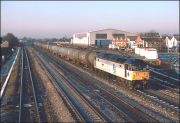 |
09.50. The first photograph shows 47350 with a train of aviation fuel from Lindsey to Langley where it will be unloaded and transported by pipeline to the nearby Heathrow airport. This working travelled via Birmingham, Hatton and Oxford and ran too early for me photograph nearer home, at this time of year, at least. |
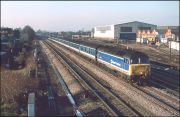 |
10.57 The Oxford to Paddington trains were all still locomotive-hauled at this time, although the NSE 47s were beginning to break into the previous monopoly held by class 50. 47714 is seen at high speed with the 10.00 to Paddington. This loco is also still around today, currently operated by Cotswold Rail and wearing the colours of Anglia Rail. Click here to see a picture of taken in 2005. 47714 in at Hinckley in Anglia livery |
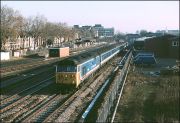 |
10.58 Some local trains to Newbury were also loco-hauled in 1989 and this is a view of 50026 on such a working. It is quite a revelation to return to this line today when every public passenger working comprises of a multiple unit of some description. It is hardly surprising that special workings, such as the VSOE and railtours, are reported so often on the various mailing lists. |
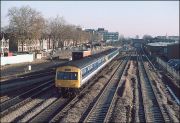 |
10.59 A Paddington to Reading local is seen here pulling away from the station stop at West Ealing. It is formed of a 2 car class 101 and 3 car 118. |
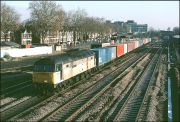 |
11.01. Freightliner traffic to and from Ripple Lane is still diagrammed to use this line, although very rarely these days with class 47 power. It was exceptionally rare in 1989 to see anything other than 47s, although the odd class 33 did still work, usually as a result of a 47 failure in the South Western area. No such luck today as 47283 takes a Ripple Lane - Southampton past West Ealing on the down relief lines. |
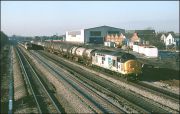 |
11.02. The frequency of traffic had really begun to pick up by now, as the rush hour embargo on freight receded. This is 37893 on the morning Micheldever to Ripple Lane empty oils tanks passing the Plasser & Theurer factory as an up HST screams by at high speed on the up main. |
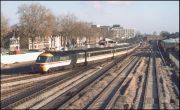 |
11.03. The first of 3 ECS moves I photographed during the day was this HST set. The purpose of this move was to turn the set so that the first class accomodation was correctly positioned at the town end, so that the holders of first class tickets had less far to walk at Paddington. |
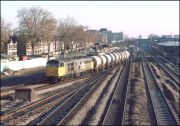 |
11.06. Following the HST shown above was a slightly more humble but possibly more interesting working. The train consists of a rake of fuel tanks hauled by 31125 and destined for Old Oak Common depot, still a major servicing location at the time. |
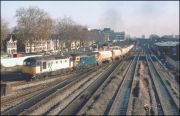 |
11.15. One of highlights of the day for me was the appearance of the Angerstein Wharf to Paddington Yard aggregate train. This was a solid class 33 turn at the time and it was good to get a pair on a heavy train on the then Western Region. 33021+33047 are seen here applying the power to get their train moving onto the Greenford Loop, from where they will turn right, head past Park Royal and enter their destination for unloading. 645 |
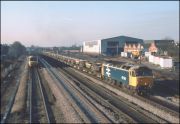 |
11.22. A clean 47540 is seen here heading East with a rake of loaded ballast wagons as a down HST recedes westward. I imagine the destination for this train was Acton Yard although this is just a guess on my part. It must be said that HSTs sounded quite impressive at West Ealing. The scream of the turbochargers so evident when they are starting away is gone and the deep "thrumming" of the exhaust as they accelerate towards top speed was most enjoyable. |
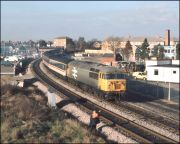 |
11.28. Possibly the most unusual working I witnessed on the this day was 56056 heading off the Greenford Loop towards Paddington with this set of empty Intercity branded coaching stock. I can only assume that the usual motive power wasn't available and that the grid was "borrowed" at Old Oak Common. |
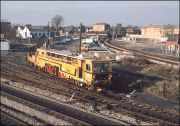 |
11.45. I have already mentioned that the Plasser & Theurer factory is located at West Ealing and one of their products, DR73106 complete with Intercity wording, is seen here having come from around the back of the works. It reversed back into the factory where, presumably, it was booked for some attention. |
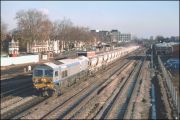 |
12.05. The new order is represented here by Foster Yeoman's 59002, a member of a 4, soon to become 5-strong class of Canadian-built heavy freight locomotives. These were the first privately-owned locomotives to run on the British rail network for many years. They were, and still are, very succesful, and were in many ways the forerunner of class 66. This train is returning to Merehead Quarry from Crawley. |
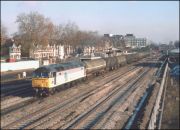 |
12.10. We have already seen a loaded oil train en-route to Langley and here is a return train of empties returning to the North East behind 47276. I think that this train was given the headcode 6E69 and I recall photographing the working further north on several occasions. |
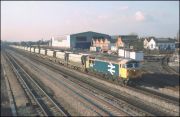 |
12.11. Stone traffic from the various quarries in the Mendips was, and still is, an important source of revenue for the railway. The first 4 class 59s, owned by Foster Yeoman, were in use by this time but class 56s still operated many of the trains. Large logo 56110 was pictured heading east with Bardon hoppers, probably going to Thorney Mill. |
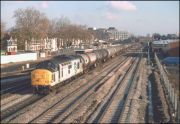 |
12.33. The second of the daily oil trains from Ripple Lane to Micheldever is seen here behind 37891. In 1989, a class 37 on a working like this was barely worth mentioning unlike the situation in the past few years when every turn of a 37's wheelsets have been recorded in detail. Following the publication in "Motive Power Monthly" of some of my black & white images from the day, I received a letter from a gentleman in Surrey asking if I had photographed a Petroleum sector class 37 as he wanted a detailed colour photograph of such a loco for modelling purposes. I was pleased to supply a print taken from the medium format transparency I took at the same time as this 35mm version. |
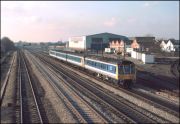 |
12.40. Network South-East liveried DMUs were constantly moving on local services - surely more interesting than the current scene although the Turbo units are still worthy of a shot in the right conditions. Here is L124 leading a 3 car 118 set past the Plasser & Theurer works, while working a Reading to Paddington service. Most enthusiasts totally ignored these trains but I am glad to have photographed at least a representative selection. I recall a conversation with a very well-known photographer active during steam and early diesel days in which he said that as GWR Prairie tank engines were so common on local services, nobody much bothered with them. He then said that requests for his photographs of them on these trains outnumbered those for the big express locos on main-line services. I operate under the same principle, and often look with fondness through my DMU collection. |
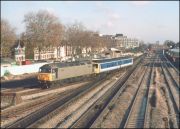 |
12.41. Another unusual working this day was the sight of plain grey 47315 hauling a class 104 unit in NSE colours onto the Greenford Loop, presumably heading to Old Oak for repair. The 47's livery was possibly one of the most uninspiring ever devised and wasn't much mproved by the addition of yellow areas; the so-called "Dutch Livery" used by the Departmental and Infrastructure Sectors. |
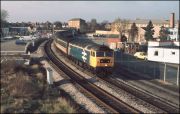 |
12.56. Another ECS move from Old Oak Common is seen here leaving the Greenford Loop behind more usual motive power, class 47 with black headcode panel, 47814. |
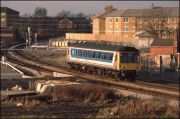 |
13.43. Trains to and from the station at Greenford were still in the hands of single units at this time - I think the only London branch to use this type of power. L122 is shown here about to leave the branch on the way to Paddington. |
_ooc_tanks_301189.jpg) |
13.47. Following closely behind the unit shown above and having discharged the load of diesel fuel at Old Oak Common, 31125 hauls its train of tanks back towards the main line. |
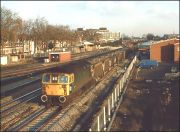 |
14.30. After a bit of a dead spell, 33108 appeared with the afternoon Hoo Junction to Meldon Quarry empty ballast wagons. This was, unusually, on the fast line whiich did not help the photographic composition. I feel that the relief lines offer the better photographs because of the slightly better angle possible. |
|
|
14.44. The next train around the Greenford Loop was from the Park Royal Guinness brewery consisting on 31248 hauling a long train of ferrywagons loaded with casks and bottles. The light was beginning to fade by now with some cloud appearing. |
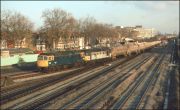 |
14.48. For a reason I cannot explain, the pair of 33s which earlier appeared on the Angerstein Wharf to Paddington aggregate train returned, but with the locomotives in reverse order. With 33047 leading 33021 the train once again turns onto the Greenford Loop. This was the final shot of the day - I was getting a bit tired by now and had just received a mouthful of abuse from a rather stoned gentleman smoking an illegal substance. Time to go... |